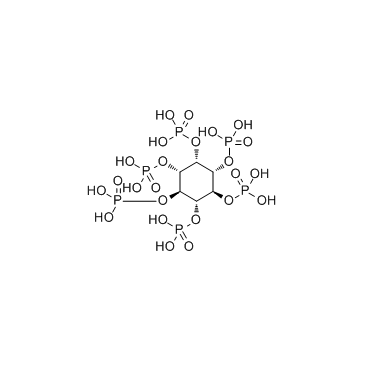Phytic acid

Phytic acid structure
|
Common Name | Phytic acid | ||
|---|---|---|---|---|
| CAS Number | 83-86-3 | Molecular Weight | 660.04 | |
| Density | 2.4±0.1 g/cm3 | Boiling Point | 1190.7±75.0 °C at 760 mmHg | |
| Molecular Formula | C6H18O24P6 | Melting Point | N/A | |
| MSDS | Chinese | Flash Point | 673.9±37.1 °C | |
| Symbol |


GHS05, GHS07 |
Signal Word | Danger | |
|
Effect of air classification and fermentation by Lactobacillus plantarum VTT E-133328 on faba bean (Vicia faba L.) flour nutritional properties.
Int. J. Food Microbiol. 193 , 34-42, (2015) The effects of air classification and lactic acid bacteria fermentation on the reduction of anti-nutritional factors (vicine and convicine, trypsin inhibitor activity, condensed tannins and phytic acid) and in vitro protein and starch digestibility of faba be... |
|
|
In Vitro Evaluation of Cu, Fe, and Zn Bioaccessibility in the Presence of Babassu Mesocarp.
J. Agric. Food Chem. 63 , 6331-7, (2015) In vitro gastrointestinal digestion of babassu mesocarp in the absence and presence of milk and lignin was performed to evaluate the bioaccessibility of Cu, Fe, and Zn. Extractions using NaOH solutions (pH 7 and 12) were carried out to evaluate the interactio... |
|
|
Role of β/δ101Gln in regulating the effect of temperature and allosteric effectors on oxygen affinity in woolly mammoth hemoglobin.
Biochemistry 52(49) , 8888-97, (2013) The oxygen affinity of woolly mammoth hemoglobin (rHb WM) is less affected by temperature change than that of Asian elephant hemoglobin (rHb AE) or human normal adult hemoglobin (Hb A). We report here a biochemical-biophysical study of Hb A, rHb AE, rHb WM, a... |
|
|
Antioxidants inhibit SAA formation and pro-inflammatory cytokine release in a human cell model of alkaptonuria.
Rheumatology (Oxford.) 52(9) , 1667-73, (2013) Alkaptonuria (AKU) is an ultra-rare autosomal recessive disease that currently lacks an appropriate therapy. Recently we provided experimental evidence that AKU is a secondary serum amyloid A (SAA)-based amyloidosis. The aim of the present work was to evaluat... |
|
|
Axillary reverse mapping using fluorescence imaging is useful for identifying the risk group of postoperative lymphedema in breast cancer patients undergoing sentinel node biopsies.
J. Surg. Oncol. 109(6) , 612-5, (2014) Axillary reverse mapping (ARM) is a novel technique for preserving the upper extremity lymphatic pathways during axillary lymph node surgery. However, there is no evidence of the usefulness of ARM for patients undergoing sentinel lymph node biopsy (SNB).Betwe... |
|
|
A type IV translocated Legionella cysteine phytase counteracts intracellular growth restriction by phytate.
J. Biol. Chem. 289(49) , 34175-88, (2014) The causative agent of Legionnaires' pneumonia, Legionella pneumophila, colonizes diverse environmental niches, including biofilms, plant material, and protozoa. In these habitats, myo-inositol hexakisphosphate (phytate) is prevalent and used as a phosphate s... |
|
|
Genetic diversity and expression profiles of cysteine phytases in the sheep rumen during a feeding cycle.
Lett. Appl. Microbiol. 59(6) , 615-20, (2014) Cysteine phytase is the main phytate-degrading enzyme of ruminant animals. To explore the genetic diversity and dynamic expression profile of cysteine phytase in sheep rumen during a feeding cycle, four transcript (0, 4, 9 and 16 h after feeding) and one DNA ... |
|
|
Nutritional potential of rice bean (Vigna umbellata): an underutilized legume.
J. Food Sci. 78(1) , C8-16, (2013) Rice bean, a less known and underutilized legume, has emerged as a potential legume because of its nutritional potential. The nutritional quality of rice bean is higher as compared to many other legumes of Vigna family. In the present study, 16 diverse rice b... |
|
|
The effects of phytic acid on the Maillard reaction and the formation of acrylamide.
Food Chem. 141(1) , 18-22, (2013) Phytic acid, myo-inositol hexaphosphoric acid, exists in substantial (1-5%) amounts in edible plant seeds. In this study the effects of phytic acid on the Maillard reaction and the formation of acrylamide were investigated. Both phytic acid and phosphate enha... |
|
|
Evaluation of the effect of processing methods on the nutritional and anti-nutritional compositions of two under-utilized Nigerian grain legumes.
Pak. J. Biol. Sci. 16(24) , 2015-20, (2013) The nutritional and anti-nutritional compositions of African Yam Bean (AYB) and Lima bean flours under different processing methods were determined. Nutritional and anti-nutritional properties studied include moisture content, crude protein, crude fibre, ash ... |